SHOULD SCHOOLS CUT SPENDING ON EXTRACURRICULARS?
What do extracurriculars add to our children's lives?
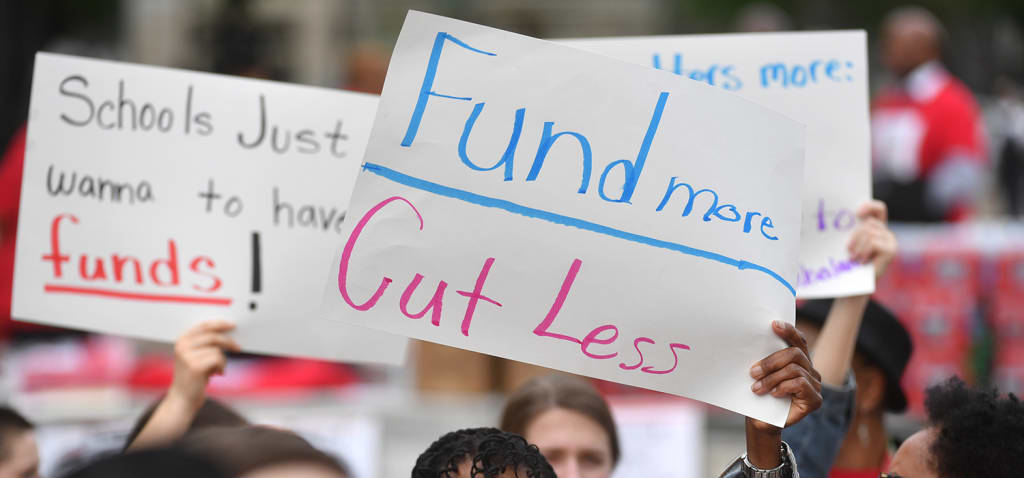
SHOULD SCHOOLS CUT SPENDING ON EXTRACURRICULARS?
American school budgets have been diminishing since the recession in 2008. Specifically, there’s been a drastic drop in state funding (which covers almost half of the school’s funds). Public Schools rely heavily on State funding, so when there’s a cutback, schools are forced to find money elsewhere and make cuts to some offered services. Unfortunately, due to the dramatic decrease in State, local funding just isn’t enough to make up the gap (Leachman). These recent cuts from the state have given rise to many questions about what to cut and what to keep. One popular thing schools have been cutting is after-school activities. Now while basic education should be the most important goal of schools, they’re doing their students a disservice by cutting these extracurricular activities.
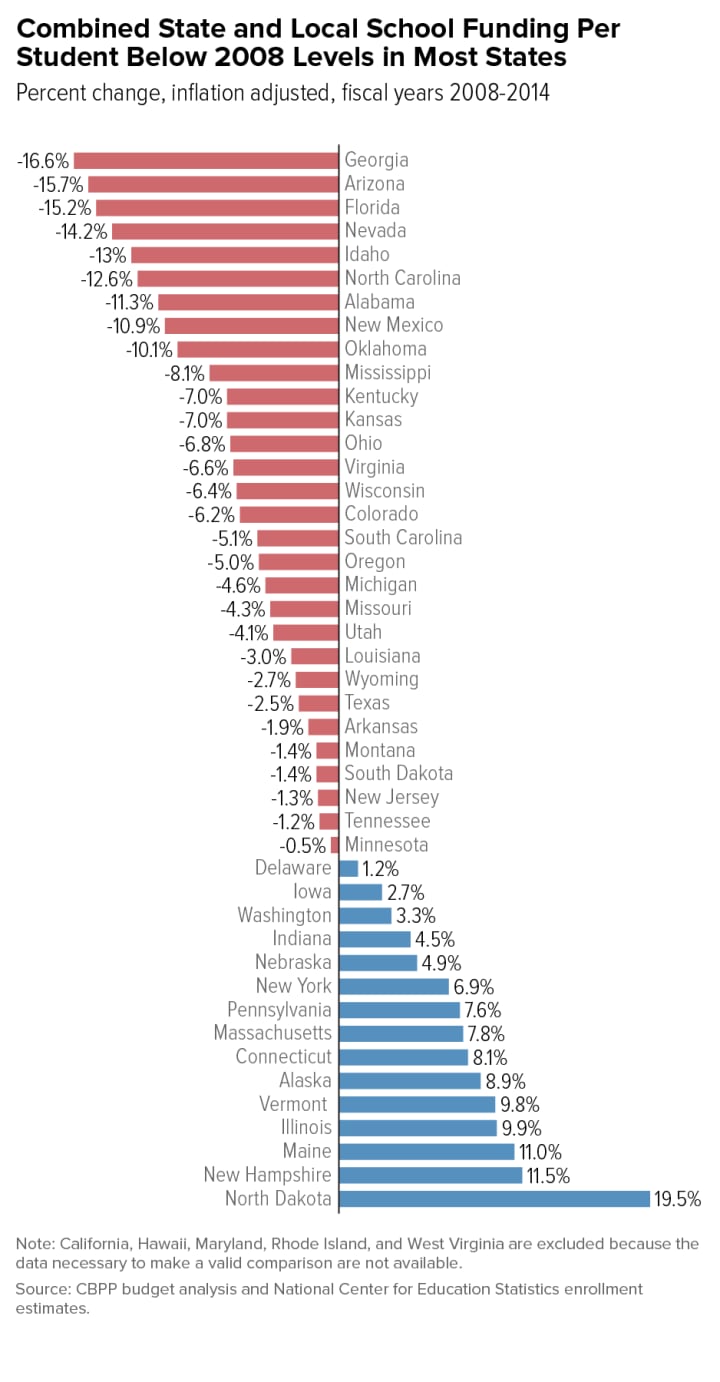
Some may think that in recent years schools have recovered from the budget cuts caused by the recession. In part, that is true. Some states, such as North Dakota, Illinois and Alaska have seen an increase in Funding per student as of 2015. But other states (Arizona, Florida, Alabama) have continued to see a decrease. The states seem evenly split between those who have a further decrease and those who are doing better than they were in 2008. Mathematically it has been shown that the lowest states for funding will not increase dramatically in the following years. In fact, in 2015 12 states cut their per student funding even more. The truth of the matter is, schools are still being affected by budget cuts yearly, while on the other end inflation isn’t slowing down. What this means is that whether we like it or not, school systems must let some things go. Of course, this is a difficult decision that affects all of the students in each district (Leachman).
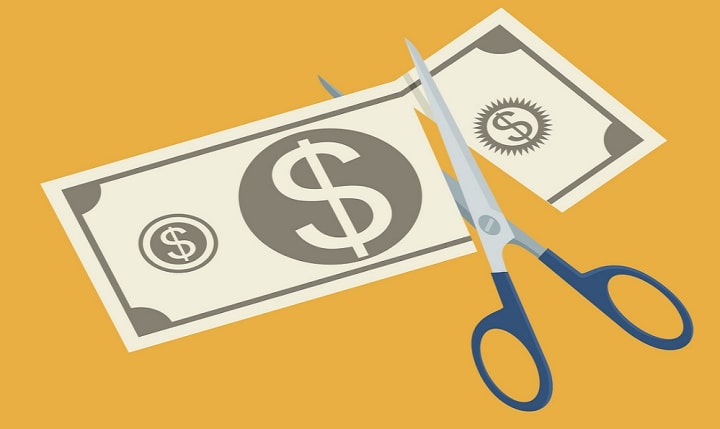
There are lots of options for cutting spending in a school, but each option has its consequences. To the dismay of one Program Quality Reviewer, many plans included cutting the Library funds in their area. A tragic sight, seeing as the Library Price initially Reviewed was the corner of a classroom, with 30-year-old books that had clean, unopened pages (Price). He goes on to say that he had slowly been gathering the resources to create a real library. But with having to fight budgets every step of the way, he becomes more unsure of his ability to win with each passing year. He finishes his thoughts off by describing his efforts as a battle; admitting that it will be straining and possibly leave aging in their wake but that it will all be worth it if they can cultivate the enjoyment of reading for children. Unfortunately, it seems many departments feel the same as Price. Every year schools must make tough decisions about what gets cut. In recent years it's become a trend to cut extracurriculars (such as art clubs, archery, tennis, even orchestras, and choral ensembles).
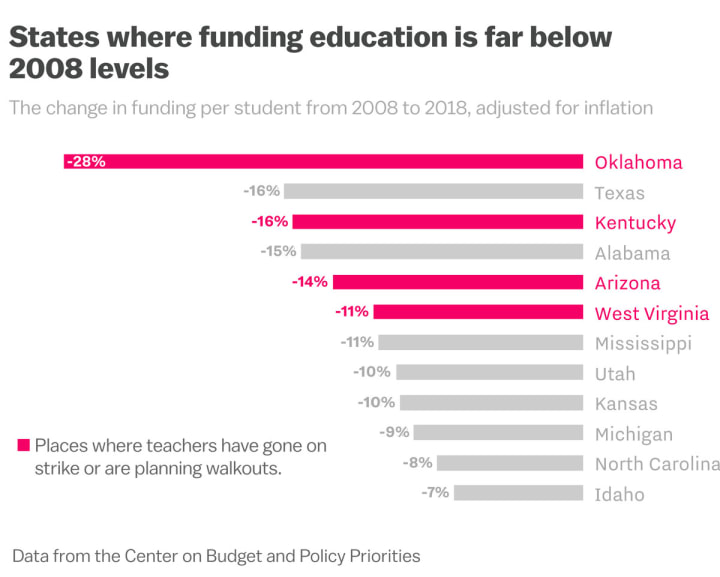
So, what is so important about keeping extracurriculars, aren’t calculators and books more important? Well, it seems there’s no simple answer to that question. While books and calculators are essential tools for your education, some studies in recent years have suggested that so are after-school activities.

The NCAA frequently reports on their graduation rates. Though an examination of those numbers done in 2014 stated that those graduation rates aren't directly related to a program's Success, I’d beg to differ. Though they do not have a way to track the academic success of those who leave the school or transfer to another NCAA college, those who do stay have been shown to have a much higher graduation rate in recent years. Part of this is due to coaches holding their players accountable for their schoolwork. Or rather, the players hold themselves accountable due to the rules in place by the coaches. One coach stated that their players currently have the highest graduation rate they’ve ever had. The biggest motivator for the NCAA players is that they know they can’t play if they don’t stay on track in college (Wolverton).
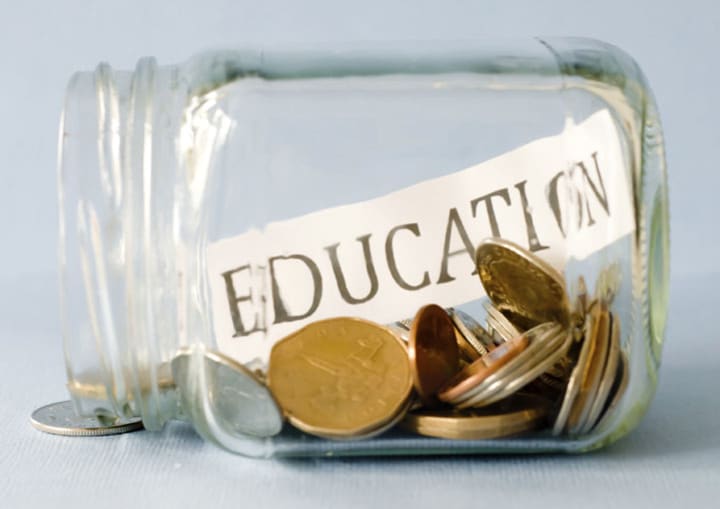
In another study done with prior high school graduates, they were asked to speak about their important experiences in school. All talked about their afterschool activities. Throughout all of the interviews, there was a similar theme; “Extracurriculars “teach a lot of the skills you need as an adult: time management, leadership, self-discipline, and persistence for doing work that isn’t extrinsically motivated”” (Kronholz). Some also mention that these activities introduced them to new ideas and ways of thinking. It expanded their horizons and gave them access to social skills and caring adults. For many, their extracurriculars helped them find a career path to follow. One student stated that extracurriculars helped her learn to balance her schoolwork with other things going on in her life.
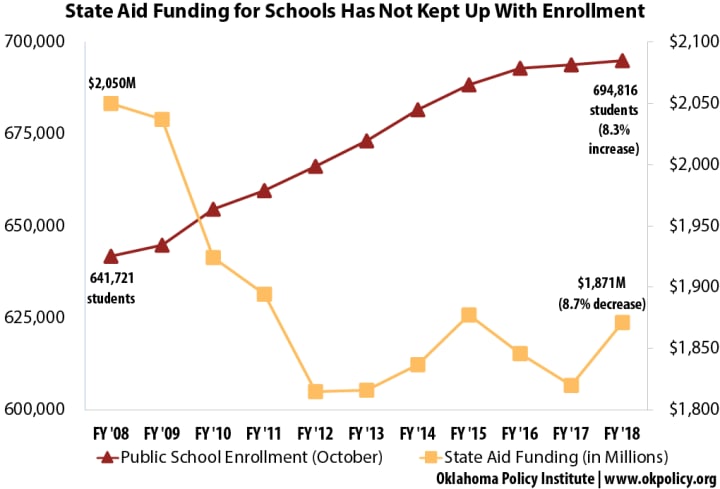
Through this study, another thing that’s been found is that those who have a passion for something will carry that passion to other parts of their life. Extracurriculars help you discover new avenues of life all while teaching you about teamwork, accountability, and time management.
Another amazing outcome of extracurriculars is that it decreases dropout rates. The main reason this is achieved is due to students’ increased eagerness to do well when they’re participating in an afterschool activity. In the past, research has found a substantial link between graduating and furthering your education to participating in extracurriculars. Part of the study looked at high school seniors. They found that those participating in extracurriculars were less likely to skip/cut class and had a 3.0 or above GPA (Kronholz). Students who enjoy extracurriculars and get good grades are less likely to drop out.

One study measured the dropout rates in New York schools with the effect of budget referenda. What was found was that there was a high impact on dropout rates- especially for 12th graders. In New York, when you’re 16 you can legally drop out on your own, so the data found had an increase in dropouts starting in the 10th grade. The study didn’t specifically investigate what the use of that money does to decrease dropout rates (Lee).
As mentioned above, after-school activities teach many life lessons and can help shape you into who you’ll be as an adult. But did you know that being involved in an extracurricular keeps lots of kids stay out of trouble? Police state that most crime committed by those under the age of 18 takes place from 3-6 pm (Kronholz). High schools let out at around 2-2:30 pm, and a good majority of afterschool activities are scheduled to take place in that 3-6 pm timeframe. Giving kids the opportunity to work with their hands and be productive after school, diminishes the possibility of them getting into trouble with the law (Kronholz).
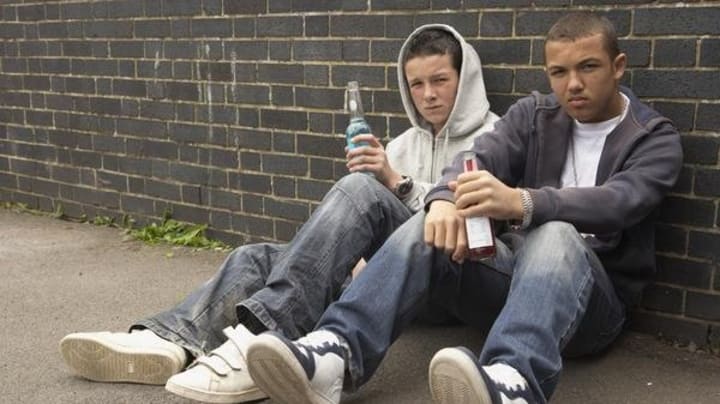
When thinking of students getting into trouble with the law you might be thinking of vandalism, speeding, and being out too late. But the crimes most committed by juveniles today are Larceny (theft), Assault, Sexual Offences, Illegal Purchases, and Other Drug and Alcohol crimes. These are serious offenses that can affect them for the rest of their lives -especially if they’re tried as an adult in the courtroom (HG.org).

In this case, the saying ‘The devil finds work for idle hands" is all too true of a statement when it comes to youth. A large part of the reason crime spikes during that 3-6 pm window is that many parents work later hours now than what used to be the norm. Juveniles who have a house to themselves for hours- or don't have a house to go to for hours- are more likely to get into mischief.
By offering activities –especially during that peak time when crime peaks and there’s less adult supervision- there will be a reduction in the crime rate for adolescents. There is a youth demographic that is more likely to fall into juvenile crime and violence than others. When you take away those kids’ activities, you’re increasing their chance of getting into trouble with the law. And as mentioned before, kids drop out of school more often when they’re not involved in sports. In some areas where there’s high gang activity, dropping out for a teen only leaves them with a few options- most of which are unsafe.
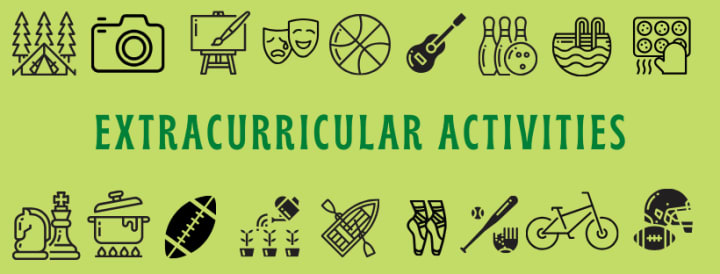
All teachers and parents want is for each child to have an equal chance at success. Unfortunately, with decreasing budgets and the fear of an educational structure falling, it has put the future of offering extracurriculars in jeopardy. But taking away extracurriculars would be a tremendous disservice to students. Studies have shown that an increase in budget means fewer dropout rates in schools.
It also shows that extracurriculars keep students more engaged in school and can increase their chance of furthering their education beyond high school. Skeptics need to do no more than think back to their own days in high school. Those who participated in activities statistically had a better outlook on their school life than those who didn’t. Extracurriculars also teach students important life lessons and even offer the chance to explore things they might have never thought about before. Children are the leaders of tomorrow, and it’s important to keep them safe and encourage them to explore. If we can keep kids and teens actively involved in extracurriculars, we can decrease the dropout and juvenile crime rate, offering our students a better path and future.

__________________________
WORKS CITED
Grogger, Jeff. “School Expenditures and Post-Schooling Earnings: Evidence from High School and Beyond.” The Review of Economics and Statistics, vol. 78, no. 4, 1996, p. 628., doi:10.2307/2109950.
HG.org. “Most Common Juvenile Crimes.” Hg.org, 2019, www.hg.org/legal-articles/most-common-juvenile-crimes-47362.
Kronholz, June. “Academic Value of Non-Academics: The Case for Keeping Extracurriculars.” Education Next, Hoover Institution. Stanford University, Stanford, CA 94305-6010. Tel: 800-935-2882; Fax: 650-723-8626; e-Mail: [email protected]; Educationnext.org/Journal/, 30 Nov. 2011, eric.ed.gov/?id=EJ968857.
Leachman, Michael, et al. “A Punishing Decade for School Funding.” Center on Budget and Policy Priorities, 28 Feb. 2018, www.cbpp.org/research/state-budget-and-tax/a-punishing-decade-for-school-funding.
Lee, Kyung-Gon, and Solomon W. Polachek. “Do School Budgets Matter? The Effect of Budget Referenda on Student Dropout Rates.” Education Economics, vol. 26, no. 2, 2017, pp. 129–144., doi:10.1080/09645292.2017.1404966.
Price, Bob. “Budgets and School Libraries: Rethinking Priorities.” Teacher Librarian, vol. 30, no. 5, June 2003, p. 63. EBSCOhost, search.ebscohost.com/login.aspx?direct=true&db=tfh&AN=10011258&site=ehost-live.
Wolverton, Brad, and Jonah Newman. “NCAA's Graduation Rates Don't Necessarily Prove Success.” Chronicle.com, 27 Oct. 2014, www.chronicle.com/article/NCAAs-Graduation-Rates-Dont/149627.
About the Creator
QuirkyMin
Aspiring writer, sharing articles of personal interest as well as original short stories.
https://linktr.ee/quirky.min
Enjoyed the story? Support the Creator.
Subscribe for free to receive all their stories in your feed. You could also pledge your support or give them a one-off tip, letting them know you appreciate their work.






Comments
There are no comments for this story
Be the first to respond and start the conversation.